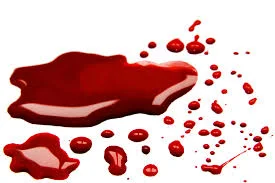Circulatory System: Disease of Blood
Blood
Blood is a red coloured liquid that flows in the blood vessels in the whole body. It is a liquid that contains cells. One of its important features is that it remains in liquid form as long as it is within blood vessels which are intact. But it clots as soon as it comes out of injured blood vessels.
This prevents excessive blood loss after any injury. Human body
has blood of volume about 1/12 the body mass i.e. about 5 liters. Out of that,
about 55% is plasma and 45% is cells. The blood volume is maintained due to the
osmotic pressure between the blood
vessels and plasma.
Components of blood
|
Component |
Contents |
|
Blood cells |
.Red blood cells. .White blood cells. .Platelets. |
|
Plasma |
.water(99%). .Proteins(8%) .Albumin. .Globulin. .Fibrinogen. .Electrolytes(0.9%) .Sodium chloride. .Sodium bicarbonate. .Calcium. .Phosphorous. .Magnesium. .Iron. .Organic compounds (0.1%) .Glucose. .Fat. .Uric
acid.
.Creatinine. .Amino acids. .Gases .Oxygen. .Carbon
dioxide. .Hormones .Antibodies. .Enzymes. |
Red blood cells
1.These are very small and biconcave disc-shaped.
2.There are 5000000 red cells per cmm.
3.Each cell has an outside covering and it contains
haemoglobin. Haemoglobin combines with oxygen and forms oxyhaemoglobin, which
circulates all over the body to supply oxygen to tissues. Haemoglobin level is
12.5g to 14g% in a woman and 14g to 16g% in a man. 14.5g% IS considered to be
100%.values above 90%are considered normal.
4.Red blood cells are produced in flat bones, ends of long
bones, and small bones, in a tissue called red bone marrow. The following of
red blood red blood cells.
.Iron.
.Folic acid.
.Vitamin B12.
.Proteins.
5.Life span of a red blood cell is about cell is about 120
days.
6.Dead red cells are removed in the spleen. The cells are
broken down, and their iron and amino acids are used again.
White blood cells
1.These cells are colorless. They are bigger than red cells.
2.There are 6000 to 11000 white blood cells per cmm.
3.The functions of white blood cells are as follows:-
.
Protection of the body from infection.
.Granulocytes phagocytosed bacteria.
.Monocytes phagocytes bacteria.
.Lymphocytes produce antibodies.
.Neutrophils and monocytes phagocytose foreign bodies.
.Granulocytes break proteins down and help remove necrotic tissue.
.Lymphocytes develop antibodies against chronic infections.
4.Various types of white blood cells are as shown in the
following table:-
White
Blood Cells
|
Type |
Cells |
|
Granulocytes |
.Neutrophil. .Eosinophil. .Basophil. |
|
Agranulocyte |
.Lymphocyte. .Monocyte. |
Blood Plasma
Functions of various components of blood plasma are as
follows:-
Component Functions
Albumin .Maintain osmotic
pressure and thereby the volume of the circulating blood.
.Carry different substances bound to it.
.Supply
protein to the cellular plasma.
Globulin .Protection
from infections.
Fibrinogen .Coagulation
of blood.
Formation of Blood
Red blood cells
1.These are formed in the red bone marrow, found in the flat
bones, and ends of long bones.
2.Each cell passes through a number of stages before
becoming mature red blood cell.
3.Immature red cells are found only in the bone marrow,
while mature red cells enter circulation. However in some diseases immature red
cells may be found in circulation.
4.The following substances are require for formation of red
blood cells.
.Iron.
.Folic acid.
.Vitamin B12: It is obtained
from the diet. Articles rich in it, are
liver, mutton, milk, eggs ,and cheese.
6.Worms in stools
7.Medications
.Salicylates.
.Cytotoxic drugs.
.Chloramphenicol.
8.Radiation therapy.
9.Occupation :Exposure to toxins.
10.Gastrointestinal disturbances
.Gastroenteritis.
.Malabsorption syndrome.
.Achlorhydria.
11.Bleeding tendency: Coagulopathies.
12.Bone pains.
13.Paresthesia in limbs: Nutritional deficiency.
The following points are noted in examination
1.Pallor:In conjunctiva, nails, tongue, Oral mucous
membrane.
2.Skin
.Pallor.
.Dry and scaly
in myxedema
3.Nails
.Flat or
spoon –shaped in iron deficiency anaemia.
.Pallor.
4.Conjunctiva
.Pallor.
.Icterus in
case of hemolytic anaemia.
5.Mouth
.Pallor.
. Smooth
tongue in pernicious anaemia.
. Gingival
hypertrophy in leukemia.
. Stomatitis in Megaloblastic anaemia.
6.Abdominal examination
.Splenomegaly in hemolytic
anaemia and leukemia.
.Hepatomegaly.
7.Per rectal examination.
8.Bones.
Investigations
1.Haemoglobin.
2.Haematocrit.
3.RBC count.
4.WBC count.
5.Blood indices: mean corpuscular volume, mean corpuscular
haemoglobin concentration.
6.Bone marrow examination.
7.Haemoglobin
electrophoresis.
8.Stools examination: Worms, occult blood.
9.Fractional test meal.
10.Barium meal.










0 Comments